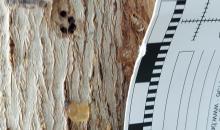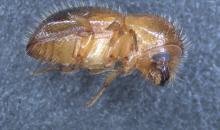Euwallacea fornicatus sensu lato(XYLBFO)
Photos
For publication in journals, books or magazines, permission should be obtained from the original photographers with a copy to EPPO.

Symptoms of Euwallacea fornicatus sensu lato
Courtesy: Wietse den Hartog NVWA (NPPO the Netherlands)
Symptoms of Euwallacea fornicatus sensu lato
Courtesy: Bas van de Meulengraaf NVWA (NPPO the Netherlands)
Symptoms of Euwallacea fornicatus sensu lato
Courtesy: Bas van de Meulengraaf NVWA (NPPO the Netherlands)
Symptoms of Euwallacea fornicatus sensu lato
Courtesy: Wietse den Hartog NVWA (NPPO the Netherlands)
Symptoms of Euwallacea fornicatus sensu lato
Courtesy: Wietse den Hartog NVWA (NPPO the Netherlands)
Symptoms of Euwallacea fornicatus sensu lato
Courtesy: Wietse den Hartog NVWA (NPPO the Netherlands)
Symptoms of Euwallacea fornicatus sensu lato
Courtesy: Wietse den Hartog NVWA (NPPO the Netherlands)
Magnolia champaca after sampling for Euwallacea fornicatus sensu lato with signs of Neocosmospora euwallaceae
Courtesy: Toralf Pfannenstill, Plant Health Inspection, State Office for Rural Development, Agriculture and Land Reallocation, Brandenburg, Germany
Adult specimen of Euwallacea fornicatus sensu lato (comparison object) - centimeter measure
Courtesy: Toralf Pfannenstill, Plant Health Inspection, State Office for Rural Development, Agriculture and Land Reallocation, Brandenburg, Germany
On Magnolia champaca, resin droplets above bore holes
Courtesy: Toralf Pfannenstill, Plant Health Inspection, State Office for Rural Development, Agriculture and Land Reallocation, Brandenburg, Germanyoralf Pfannenstill
Bore holes and resin droplets on Magnolia champaca of Euwallacea fornicatus sensu lato
Courtesy: Toralf Pfannenstill, Plant Health Inspection, State Office for Rural Development, Agriculture and Land Reallocation, Brandenburg, Germany
Magnolia champaca after sampling for Euwallacea fornicatus sensu lato
Courtesy: Toralf Pfannenstill, Plant Health Inspection, State Office for Rural Development, Agriculture and Land Reallocation, Brandenburg, Germany
Magnolia champaca, bore holes, ca. 1 mm in diameter of Euwallacea fornicatus sensu lato
Courtesy: Toralf Pfannenstill, Plant Health Inspection, State Office for Rural Development, Agriculture and Land Reallocation, Brandenburg, Germanyralf Pfannenstill
Bore holes and resin droplets on Magnolia champaca of Euwallacea fornicatus sensu lato
Courtesy: Toralf Pfannenstill, Plant Health Inspection, State Office for Rural Development, Agriculture and Land Reallocation, Brandenburg, Germany
Magnolia champaca after sampling for Euwallacea fornicatus sensu lato with signs of Neocosmospora euwallaceae
Courtesy: Toralf Pfannenstill, Plant Health Inspection, State Office for Rural Development, Agriculture and Land Reallocation, Brandenburg, Germany
Typical discharge of drill dust "tooth-picks" Euwallacea fornicatus sensu lato on Ficus sp.
Courtesy: Toralf Pfannenstill, Plant Health Inspection, State Office for Rural Development, Agriculture and Land Reallocation, Brandenburg, Germany








